The problem seemed interesting to me. So I tried to implement and this is what I achieved (you can also see the video here) which is pretty smooth.

So you can try something like this:
Define CustomLinearLayoutManager extending LinearLayoutManager like this:
public class CustomLinearLayoutManager extends LinearLayoutManager {
public CustomLinearLayoutManager(Context context, int orientation, boolean reverseLayout) {
super(context, orientation, reverseLayout);
}
@Override
public boolean canScrollVertically() {
return false;
}
}
and set this CustomLinearLayoutManager to your parent RecyclerView.
RecyclerView parentRecyclerView = (RecyclerView)findViewById(R.id.parent_rv);
CustomLinearLayoutManager customLayoutManager = new CustomLinearLayoutManager(this, LinearLayoutManager.HORIZONTAL,false);
parentRecyclerView.setLayoutManager(customLayoutManager);
parentRecyclerView.setAdapter(new ParentAdapter(this)); // some adapter
Now for child RecyclerView, define custom CustomGridLayoutManager extending GridLayoutManager:
public class CustomGridLayoutManager extends GridLayoutManager {
public CustomGridLayoutManager(Context context, AttributeSet attrs, int defStyleAttr, int defStyleRes) {
super(context, attrs, defStyleAttr, defStyleRes);
}
public CustomGridLayoutManager(Context context, int spanCount) {
super(context, spanCount);
}
public CustomGridLayoutManager(Context context, int spanCount, int orientation, boolean reverseLayout) {
super(context, spanCount, orientation, reverseLayout);
}
@Override
public boolean canScrollHorizontally() {
return false;
}
}
and set it as layoutManger to the child RecyclerView:
childRecyclerView = (RecyclerView)itemView.findViewById(R.id.child_rv);
childRecyclerView.setLayoutManager(new CustomGridLayoutManager(context, 3));
childRecyclerView.setAdapter(new ChildAdapter()); // some adapter
So basically parent RecyclerView is only listening to horizontal scrolls and child RecyclerView is only listening to vertical scrolls.
Along with that, if you also want to handle diagonal swipe (which is little skewed to either vertical or horizontal), you can include a gesture listener in the parent RecylerView.
public class ParentRecyclerView extends RecyclerView {
private GestureDetector mGestureDetector;
public ParentRecyclerView(Context context) {
super(context);
mGestureDetector = new GestureDetector(this.getContext(), new XScrollDetector());
// do the same in other constructors
}
// and override onInterceptTouchEvent
@Override
public boolean onInterceptTouchEvent(MotionEvent ev) {
return super.onInterceptTouchEvent(ev) && mGestureDetector.onTouchEvent(ev);
}
}
Where XScrollDetector is
class XScrollDetector extends GestureDetector.SimpleOnGestureListener {
@Override
public boolean onScroll(MotionEvent e1, MotionEvent e2, float distanceX, float distanceY) {
return Math.abs(distanceY) < Math.abs(distanceX);
}
}
Thus ParentRecyclerView asks child view (in our case, VerticalRecyclerView) to handle the scroll event. If the child view handles then parent does nothing else parent eventually handles the scroll.
